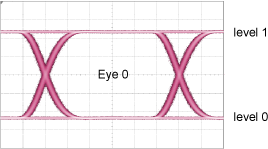:MEASure:JITTer:DCD
Command Syntax
:MEASure:JITTer:DCD
Query Syntax
:MEASure:JITTer:DCD?
Description
For NRZ measurements, moves the Duty Cycle Distortion (DCD) measurement to the top of the Jitter table. For PAM4 measurements, moves the measurement to the top of the Eye table. Displays the measurement if it is not already shown on the table. The query form of the command returns the measured value. DCD is derived from the Composite DDJ Histogram graph. DCD is the difference between the mean of the histogram of the rising edge positions and the mean of the histogram of the falling edge positions.
NRZ Waveform

Measurement Identification
Avoid subtle programming errors! To ensure that the correct measurement is installed or queried, always explicitly identify a measurement when installing a measurement or querying a measured value, status, or detail. To identify a measurement, specify the measurement's source waveform (:SOURce child command). With some measurements, you may also need to specify other identifying values. Generally, when selecting a measurement using FlexDCA's GUI, if a dialog appears prompting you to select values, you should explicitly specify these values when remotely identifying the measurement. More information.
For example, to return the status of the measurement, :MEASure:JITTer:DCD:
flex.write(':MEASure:JITTer:DCD:SOURce CHAN1A')
if flex.query(':MEASure:JITTer:DCD:STATus?') == 'CORR';
measurement = flex.query(':MEASure:JITTer:DCD?')
else:
details = flex.query(':MEASure:JITTer:DCD:STATus:DETails?')
reason = flex.query(':MEASure:JITTer:DCD:STATus:REASon?')
Child commands for measurement identification:
:MEASure:JITTer:DCD:SOURce
Example Command Sequence
:SYSTem:MODE JITTer :MEASure:JITTer:DCD:SOURce CHAN1A :MEASure:JITTer:DCD?
Measurement Ready?
To confirm that the measurement is ready to read, you can query the measurement's status:
if ('CORR' in Flex.query(':MEASure:JITTer:DCD:STATus?')):
measurement = Flex.query(':MEASure:JITTer:DCD?')
If averaging is turned on (:ACQuire:AVERaging), you can also confirm if the measurement result is ready by comparing the number of specified averages (:ACQuire:ECOunt?) versus the number of measurement sweeps that have occurred (:MEASure:JITTer:DCD:COUNt?). The technique uses the :COUNt? common measurement query. For example,
if (Flex.query(':MEASure:JITTer:DCD:COUNt?') >= Flex.query(':ACQuire:ECOUNt?')):
measurement = Flex.query(':MEASure:JITTer:DCD?')
You can also use an acquisition limit lest to test that a number of waveform samples, or pattern acquisitions have completed before returning a measurement. Refer to the :LTESt:ACQuire:CTYPe command.
Common Measurement Child Queries
This command supports the use of the following common measurement queries: :LOCation?, :COUNt?, :MAXimum?, :MINimum?, :MEAN?, and :SDEViation?.